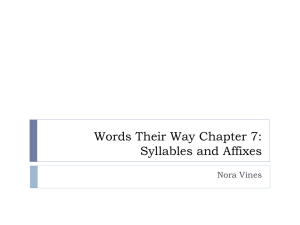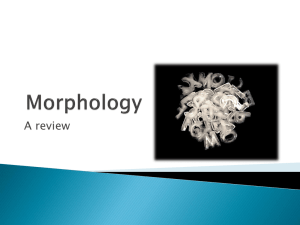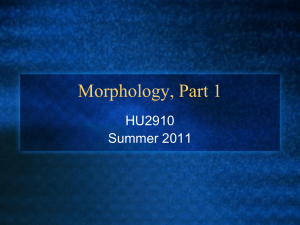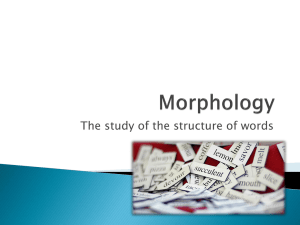Types of morphemes
advertisement
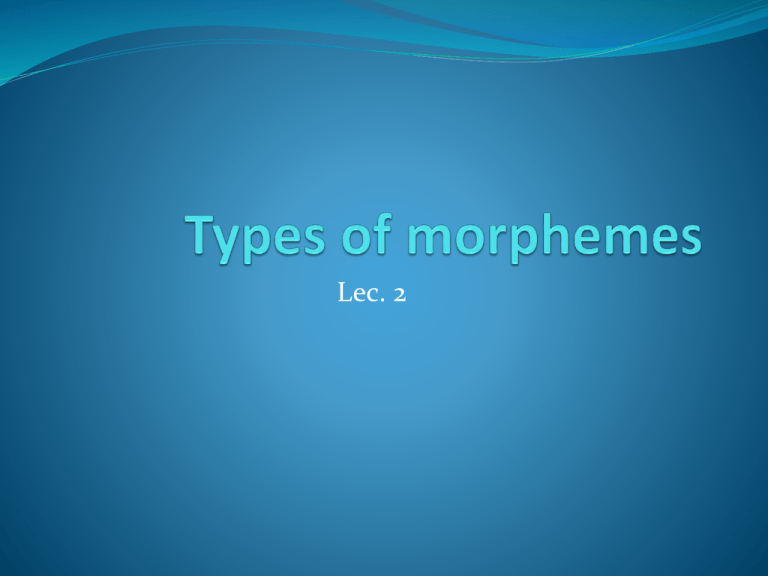
Lec. 2 Morphology & Morphemes Our morphological knowledge has two components: knowledge of the individual morphemes, knowledge of the rules that combine them. and Morphology = morph + ology (science of word forms) Words consist of meaningful units E.g. writers, reading, unripe, overdose, kingdom Morphology & Morphemes Morphology is concerned with the structure of words which is part of the implicit linguistic knowledge of all native speakers, whether or not they know anything about the history of the language they speak. e.g. help, helpful, helpfulness, helpless, helplessness HELP Examples One morpheme desire Two morphemes desirable Three morphemes desirability Four morphemes undesirability Roots Root: A morpheme which is the basic part of a word and which may, in many languages, occur on its own. (man, hold, book). A root is the base form of a word which cannot be further analyzed without total loss of identity. It is that part of the word left when all the affixes are removed. e.g. Knowingly – brainlessness – rediscover – insufferable – actions - breakage Roots Roots may be joined to other roots (house +hold = household(, and/ or take affixes ROOT word-forms walk walks, walking, walked, (house + hold= household), and/ or take affixes (man + ly = manly) (cold +ness = coldness) (manly, coldness). Exercise Identify the roots in each of the followings: knowingly brainlessness untainted Unrepeated Paranormal unrepeated rediscover insufferable disinherited undeveloped McDonaldization Morphological Morphemes Morphemes FREE BOUND BASES AFFIXES pathology Frog prefixes infixes suffixes Free & bound Roots can be either free morphemes or bound morphemes I. Free morphemes Free morphemes are roots which can stand on their own Man – book – tea – sweet – cook – bet – very – aardvark – pain – rose -understand 1. Lexical morphemes 2. Function words I. Free morphemes *Content words Lexical morphemes Function words Nouns (frog– man-John) Articles (the – a – an) Adjectives (good – kind ) Demonstratives (this – that ) Verbs (walk- write) Pronouns (I– she – it – they) Adverbs (very – well) Conjunctions (and – but) Prepositions (with – to –in ) II. Bound morphemes/ Affixes Bound morphemes are roots which cannot stand on their own. They always occur as being attached to other morphemes. -mit -ceive -ology permit – commit – admit perceive – receive – conceive – deceive biology – psychology - pathology II. Bound morphemes/ Affixes An affix is abound morpheme that can be added to a word (root), and which changes the meaning or function of the word. There are 3 types of affixes: 1. a prefix is attached before a root (re-, un-, dis-, im-) 2. a suffix is attached after a root (-ly, -er, -ist,-s) 3. an infix is attached within a root Exercise Identify the affixes: unemployment untouchable unsystematically present (v) misunderstand friendship abstraction moralize alcoholic mistreatment unbelievable inaccurate enlarge darken Base A base is any unit to which affixes of any kind can be added: 1. inflectional affixes (syntactic reasons) 2. derivational affixes (meaning and/ or grammatical category) All ROOTS are BASES Stem That part of a word that occurs before an inflectional affix is or can be added. For example, (book + s = books). The stem of a word may be: 1. A simple stem consisting of only one morpheme (a root), e.g. work 2. A root plus a derivational affix, e.g. work + er =worker 3. Two or more roots, e.g. work + shop = workshop. Bound Morphemes morphological information derivational morphemes AFFIXES Inflectional morphemes Inflectional morphemes Inflectional morphemes are bound morphemes that have a strictly grammatical function. Inflectional morphemes never change the syntactic category of the words or morphemes to which they are attached. E.g. I sail the ocean blue He sails the ocean blue John sailed the ocean blue John has sailed the ocean blue John is sailing the ocean blue English Inflectional Morphemes 1. -s (third-person singular plural) 2. -ed (past tense) 3. -ing (progressive) 4. -en (past participle) 5. -s (plural) 6. -’s (possessive) 7. -er (comparative) 8. -est (superlative) Inflectional morphemes Unlike derivational morphemes, inflectional morphemes: don’t change the part of speech 2. don’t pile up, only one ends a word 1. Examples Cats Mother-in-laws Oxen Commitments Treated Sunburns Larger Morphemes Talking Shortest Asks John’s Derivational Morphemes Derivational morphemes are bound morphemes that are added to a root morpheme or stem to derive a new word with a new meaning. Derivational morphemes sometimes change the word-class that a base belongs to, and/ or change the meaning of the base to which they are attached. Derivational morphemes have clear semantic content, and some DA can be treated as independent words (e.g. full) E.g. Pure (n) purify (v) Logic (n) logical (adj) Derivational Morphemes Derivational morphemes are of 3 types: Prefixes 2. Infixes 3. Suffixes 4. Other bound morphemes (pathology) 1. Derivational morphemes Unlike inflectional morphemes, derivational morphemes: sometimes change the word-class the way they combine with base is mainly arbitrary more than one DA can be added to the base E.g. antidisestablishment English Derivational Morphemes class-changing 1. Nouns Adjective 2. Verbs Noun health + full = healthful propose + al = proposal boy + ish = boyish clear + ance = clearance Elizabeth + an = Elizabethan accuse + ation = accusation life + like = lifelike confer + ence = conference alcohol + ic = alcoholic free + dom = freedom picture + esque = picturesque sing + er = singer affection + ate = afectionate predict + ion = prediction virtue + ous = virtuous brand + ish = brandish English Derivational Morphemes class-changing 3. Adjective adverb Nouns verbs exact + ly = exactly moral + ize = moralize quiet + ly = quietly vaccine + ate = vaccinate haste + n = hasten English Derivational Morphemes class-changing Adjectives Noun Verb Adjective tall + ness = tallness read + able = readable specific + ity = specificity create + ive = creative feudal + ism = feudalism run + y = runny abstract + ion = abstraction migrat + ory = migratory true + th = truth English Derivational Morphemes class-maintaining Noun Noun Verb Verb friend + ship = friendship un + do = undo human + ity = humanity re + cover = recover man + hood = manhood king + dom = kingdom English Derivational Morphemes class-maintaining Adjective Adjective pink + ish = pinkish in + flammable = inflammable English Derivational Morphemes class-changing 1. 2. 3. 4. 5. 6. NV VN N Adj. Adj. N Adj. V Adj. Adv. joy-enjoy motivate - motivation care - careful true - truth soft –soften / wide - widen careful - carefully English Derivational Morphemes class-maintaining N N (concrete abstract) Man manhood King kingdom Friend friendship Exercise Identify the inflectional affixes, derivational affixes, roots, bases, & stems in the following: unbelievable - actors – renewed – faithfully mistreatment - pickpockets – window-cleaners insanity – psychology – shortest - unhappiness unspeakable – uncivilized – McDonaldization - mistreatment Inflectional affix Derivational affix Root - mis- + -ment treat Stem Base



